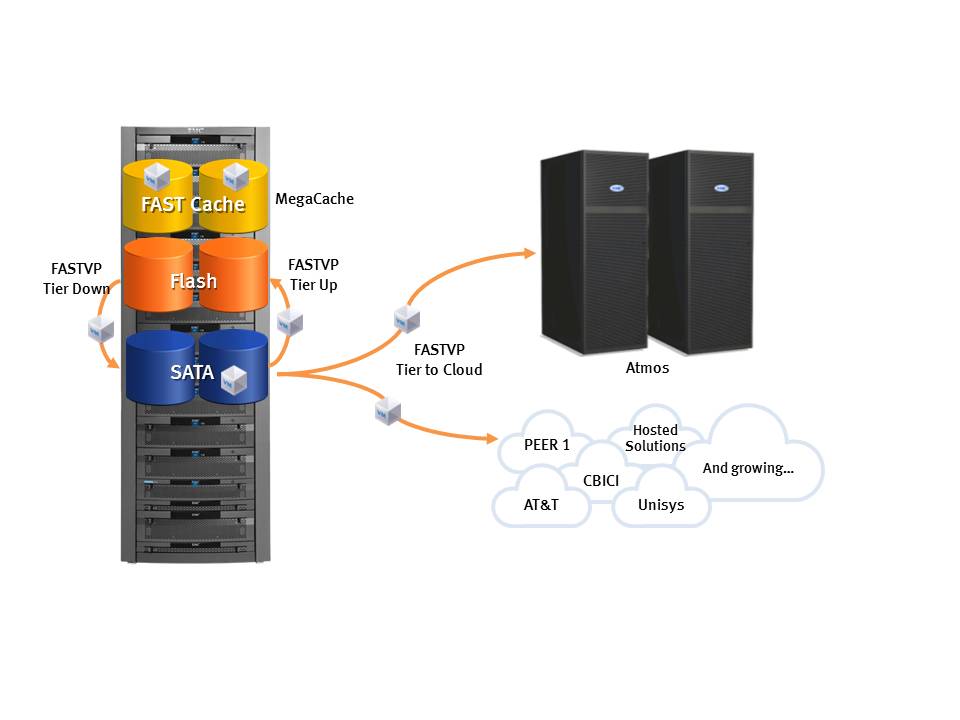Today, EMC announced the new VNX and VNXe Unified Storage platforms that merge the functionality of, and replaces, EMC’s popular Clariion and Celerra products. VNX is faster, more scalable, more efficient, more flexible, and easier to manage than the platforms it replaces.
Key differences between CX4/NS and VNX:
- VNX replaces the 4gb FC-Arbitrated Loop backend busses with 6gb SAS point-to-point switched backend.
- Fast and Reliable
- VNX supports both 3.5” and 2.5” SAS drives in EFD (SSD), SAS, and NearLine-SAS varieties.
- Flexible and Efficient
- VNX has more cache, more front-end ports, and faster CPUs
- Fast and Flexible
- VNX systems can manage larger FASTCache configurations.
- Fast and Efficient
- VNX builds on the management simplicity enhancements started in EMC Unisphere on CX4/NS by adding application aware provisioning.
- Simple and Efficient
- VNX allows you to start with Block-only or NAS-only and upgrade to Unified later if desired, or start with Unified at deployment.
- Cost Effective and Flexible
- VNX will support advanced data services like deduplication in addition to FASTVP, FASTCache, Block QoS, Compression, and other features already available in Clariion and Celerra.
- Flexible and Efficient
Just as with every manufacturer, newer products take advantage of the latest technologies (faster Intel processors and SAS connectivity in this case,) but that’s only part of the story with VNX.
Earlier, I mentioned Application Aware Provisioning has been added to Unisphere:
Prior to Application Aware Unisphere, if tasked with provisioning storage for Microsoft Exchange (for example), a storage admin would take the mailbox count and size requirements, use best practices and formulas from Microsoft for calculating required IOPS, and then map that data to the storage vendors’ best practices to determine the best disk layout (RAID Type, Size, Speed, quantity, etc). After all that was done, then the actual provisioning of RAID Groups and/or LUNs would be done.
Now with Application Aware Unisphere, the storage admin simply enters the mailbox count and size requirements into Unisphere and the rest is done automatically. EMC has embedded the best practices from Microsoft, VMWare, and EMC into Unisphere and created simple wizards for provisioning Hyper-V, VMWare, NAS, and Microsoft Exchange storage using those best practices.
Combine Unisphere’s Application Aware Provisioning with the already included vCenter integration, and support for VMWare VAAI and you have a broad set of integration from the application layer down through to the storage system for optimum performance, simple and efficient provisioning, and unparalleled visibility. This is especially useful for small to medium sized businesses with small IT departments.
EMC has also simplified licensing of advanced features on VNX. Rather than licensing individual software products based on the exact features you want, VNX has 5 simple Feature Packs plus a few bundle packs. The packs are created based on the overall purpose rather than the feature. ie: Local Protection vs. Snapshots or Clones
- FAST Suite includes FASTVP, FASTCache, Block QoS, and Unisphere Analyzer
- Security and Compliance Pack includes File Level Retention for File and Block Encryption
- Local Protection Pack includes Snapshots for block and file, full copy clones, and RecoverPoint/CDP
- Remote Protection Pack includes Synchronous and Asynchronous replication for block and file as well as RecoverPoint/CRR for near-CDP remote replication of block and.or file data.
- Application Protection Pack extends the application integration by adding Replication Manager for application integrated replication and Data Protection Advisor for SLA based replication monitoring and reporting.
You can also get the Total Protection Pack which includes Local Protection, Remote Protection, and Application Protection packs at a discounted cost or the Total Efficiency Pack which includes all five. That’s it, there are no other software options for VNX/VNXe. Compression and Deduplication are included in the base unit as well as SANCopy. You will also find that the cost of these packs is extremely compelling once you talk with your EMC rep or favorite VAR.
So there you have it — powerful, simple and efficient storage, unified management, extensive data protection features, simplified licensing, and class leading functionality (FASTVP, FASTCache, Integrated CDP, Quality of Service for Block, etc) in a single platform. That’s Unified, That’s EMC VNX.
I didn’t have time to touch on VNXe here but there is even more cool stuff going on there. You can read more about these products here..
- http://chucksblog.emc.com/chucks_blog/2011/01/introducing-the-vnx-series.html
- http://chucksblog.emc.com/chucks_blog/2011/01/emcs-record-breaking-product-launch.html
- http://storagezilla.typepad.com/storagezilla/2011/01/putting-it-together-with-pat-gelsinger.html
- http://storagezilla.typepad.com/storagezilla/2011/01/vnxe-cherry-bomb.html
- http://stevetodd.typepad.com/my_weblog/2011/01/vnxe.html
- http://storagezilla.typepad.com/storagezilla/2011/01/vnx-notes.html
- http://storagezilla.typepad.com/storagezilla/2011/01/vnx-its-showtime.html
- http://powerwindows.wordpress.com/2011/01/18/emcs-new-vnxe-screenshot-tour



